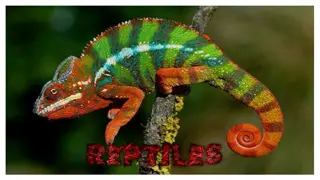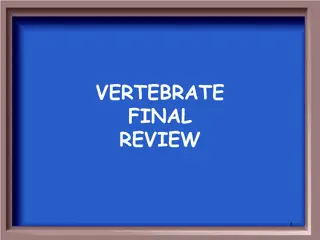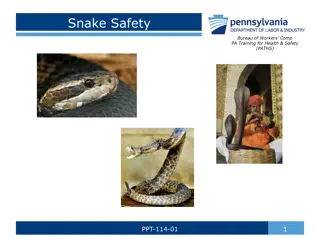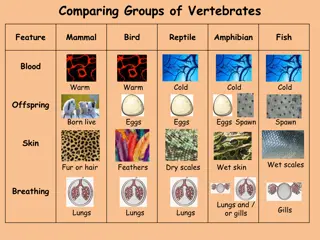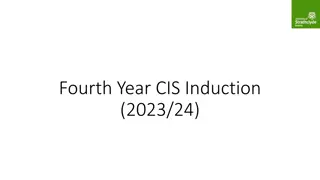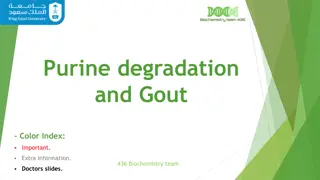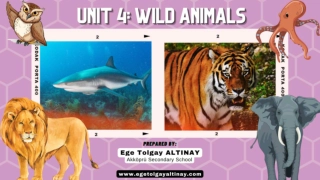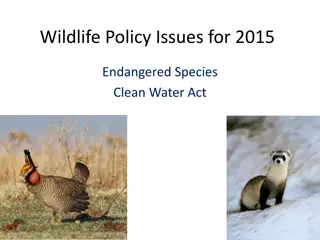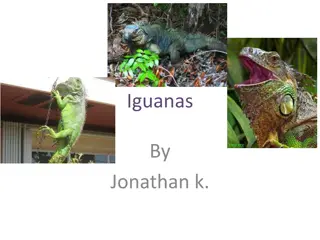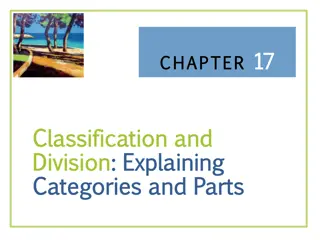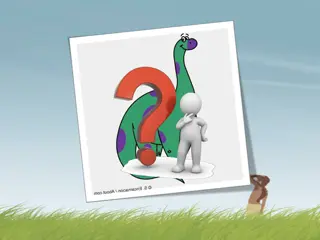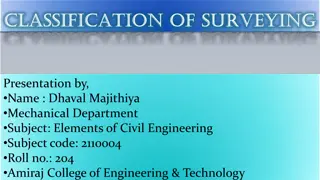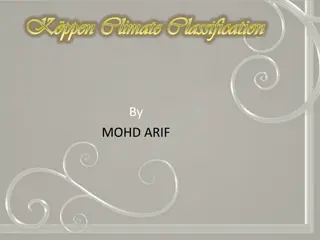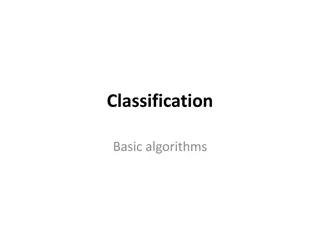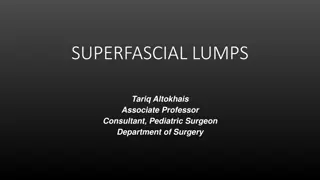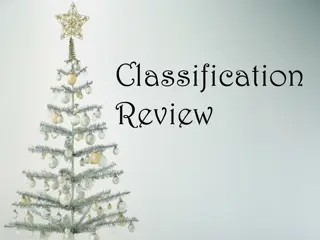Understanding the Classification and Features of Reptiles
Reptiles belong to the Class Reptilia and are known for their cold-blooded nature, dry skin with epidermal scales, and unique skeletal features. They are classified into different subclasses and orders based on their characteristics. The distinct skull structures of anapsids and synapsids define their evolutionary history. This comprehensive guide explores the salient features, classification, and skull structures of reptiles, shedding light on their fascinating biology.
Download Presentation

Please find below an Image/Link to download the presentation.
The content on the website is provided AS IS for your information and personal use only. It may not be sold, licensed, or shared on other websites without obtaining consent from the author. Download presentation by click this link. If you encounter any issues during the download, it is possible that the publisher has removed the file from their server.
E N D
Presentation Transcript
Classification of Reptilia Dr. Shilly Elizabeth David
Salient Features Reptiles means Creeping Study of reptiles Herpetology Cold- blooded(poikilothermic) Exoskeleton of epidermal scales, scutes or bony plates Skin dry, horny & non glandular (without skin glands) Heart with 2 auricle and incompletely divide ventricle except crocodiles whose have 4 chambers R.B.C. oval and nucleated, Cloaca present Uricotelic excretion
Salient Features Metanephric kidney Cranial nerves 12 pairs (except snakes which have 10 pairs) Sexual dimorphism present Fertilization internal Eggs are cleidoic (large yolky eggs with calcareous shell) No larval stage Amniotes (all 4extra-embryonic membranes present)
Classification Class Reptilia Subclass Anapsida Subclass Diapsida Subclass Synapsida Subclass Parapsida Order Chelonia (Chelone) Order Order Ichthyosauria (Ichthyosaurus) Therapsida (Cynognathus) Order Squamata (Chamaelon, Draco) Order Crocodilia (Crocodile) Order Rhynchocephalia (Sphenodon)
Skull Structure The number and arrangement of holes (temporal fenestrae) behind the eye socket in the skull With respect to these fenestrae, the most important bones are the POST-ORBITAL and SQUAMOSAL bones. PO = post orbital bone PO SQ SQ = squamosal bone
Anapsids The anapsid condition is characterized by the absence of temporal fenestrae. PO SQ It is the most primitive skull type among the amniotes.
Anapsids The anapsid group includes the earliest stem reptiles (captorhinomorphs) and perhaps the turtles and tortoises (although this is debated). captorhinomorph turtle
Synapsids The synapsid condition is characterized by a single opening below the junction of the post orbital and squamosal bones. PO SQ
Synapsids The synapsid group includes: Pelycosaurs (sail-backed reptiles) Mammal-like reptiles (therapsids) True mammals
Diapsids The diapsid condition is characterized by two openings one above and one below the junction of the post orbital and squamosal bones. PO SQ
Diapsids The diapsid group is represented by all of the archosaurs ( ruling reptiles ). The diapsid group includes: Snakes and lizards Thecodonts (ancestral group of higher diapsids)
Diapsids Crocodilians (e.g. crocodiles and alligators) Pterosaurs (flying reptiles)
Diapsids Dinosaurs Birds
Euryapsids The euryapsid condition is characterized by a single opening above the junction of the post orbital and squamosal bones. PO SQ
Euryapsids The euryapsid group is represented by extinct marine reptiles Ichthyosaurs Plesiosaurs
To Summarize: Synapsids: (one temporal fenestra low in skull) Pelycosaurs Mammal-like reptiles Mammals Euryapsids: (one temporal fenestra high in skull) Icthyosaurs Plesiosaurs Anapsids: (no temporal fenestrae) Turtles/tortoises Captorhinomorphs Diapsids: (two temporal fenestrae) Lizards and snakes Crocodilians Pterosaurs Dinosaurs, Birds
Amphicoelous vertebrae are found in fishes apoda and some urodela. These have concavities on anterior as well as posterior side of the centrum. Procoelous vertebrae are concave on the anterior side and convex on the posterior side of the centrum. Ex. Anura and reptiles. Opisthocoelous vertebrae possess concavity on the posterior side while convexity on the anterior side, as found in salamanders, parrots and ungulates. Heterocoelous : Vertebral centra in which the anterior end is convex in vertical section, concave in horizontal section, while the posterior end has these outlines reversed. Acoelous : Acoelous vertebrae are flattened on both ends. Mammals are acoelous.
Subclass I Anapsida Oldest known reptiles; turtles and extinct Permian (around 270 million years ago) forms Completely ossified skeleton and body usually covered with scales or horny plates; once the dominant land animals Primitive reptile having no opening in the temporal region of the skull; all extinct except turtles Sternum absent Jaws lack teeth and covered by horny sheath Limbs are paddle like or normal Eggs laid on land, parental care by females
Chelone Chelonia mydas Green turtles because of the color of the flesh Largest turtles ranging from 71 to 153 cms ; Weight - 205 kg Limbs - paddle-like for swimming Head small compared to their body size Males larger than females and the tail is longer, extending well beyond the shell Eggs laid in pits Carapace olive to brown/ black, depending on the geographic location of the species. Green turtles cannot pull their heads inside of their shells. Two sub-species - Chelonia mydas mydas & Chelonia mydas agassizii.
Subclass II Parapsida This group includes extinct forms. Includes Ichthyosaurs, Araeoscelis of Mesozoic era Reptiles with one temporal fossa, placed high up on the skull- Supratemporal fossa, seen below postorbital & supra temporal bone & above parietal Araeoscelis
Subclass II Parapsida Ichthyosaur means 'fish-lizard , extinct about 90 million years ago Body spindle shaped, head produced into a long snout Sharp teeths on upper and lower jaws Limbs modified into paddles & exhibited hyperdactyly and hyperphalangy Dorsal & caudal fins present
Subclass III Diapsida Consists of supratemporal and infratemporal fossae & separated by postorbital & squamosal bones Infratemporal fossa bounded below by quadratojugal & jugal bones 3 orders Squamata Rhynchocephalia Crocodilia
Subclass III Diapsida Order I : Rhynchocephalia Body small, elongated & lizard like Diapsid skull, quadrate fixed Skin covered with scales & mid dorsal spines Limbs pentadactyl, clawed & burrowing A parietal foramen with vestigial pineal eyes present Represented by only one genus Sphenodon (Tuatara)
Subclass III Diapsida Sphenodon Rare group of reptiles that inhabit the rocky islands off the coast of New Zealand They are cold-blooded and live in cool habitats They grow slowly and have a long lifespan. Reproduce until 60 years old Posses two rows of teeth in their upper jaw and one row of teeth in their lower jaw Diapsid skull with two temporal openings, Amphicoelous vertebrae Prominent parietal eye on top of head First tuatara appeared during the Mesozoic Era, about 220 million years ago & has not undergone much evolutionary changes Living fossil
Subclass III Diapsida Order II : Squamata Diapsid skull, quadrate movable Skin horny epidermal scales, shields, spines Elongated & cylindrical body, long tail Limbs present/ absent Vertebrae procoelous, Ribs single headed Cloacal opening is a transverse slit Male Double copulatory organ Represented by Lizards & Snakes
Subclass III Diapsida Lacertilia Lizards There are more than 4,500 species of lizards alive today, making them the most diverse group of all squamates. Members of this group include chameleons, geckos, night lizards, blind lizards, skinks Ophidia- Snakes There are about 2,900 species of snakes alive today. Members of this group include pythons, vipers, blind snakes, mole vipers and sunbeam snakes. Snakes have no limbs but their legless nature doesn't stop them from being among the world's most formidable reptilian predators.



